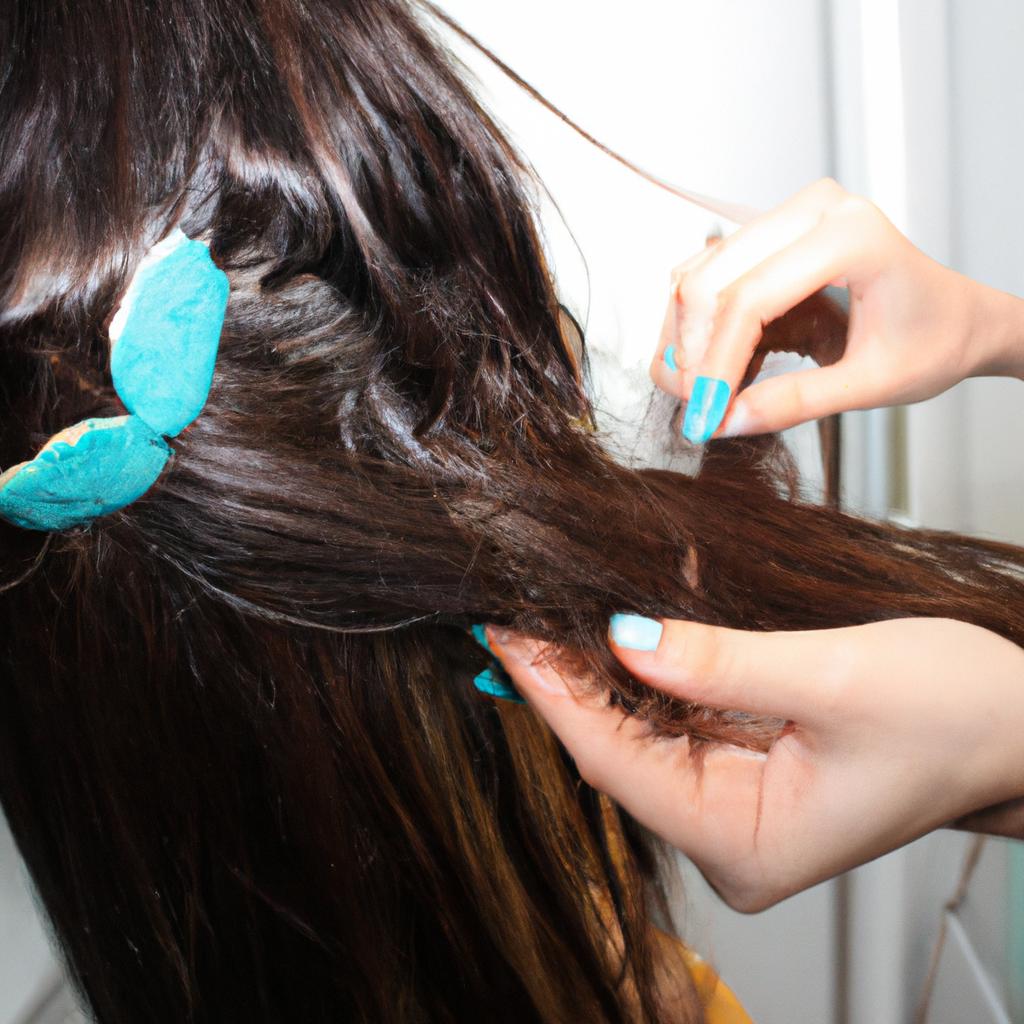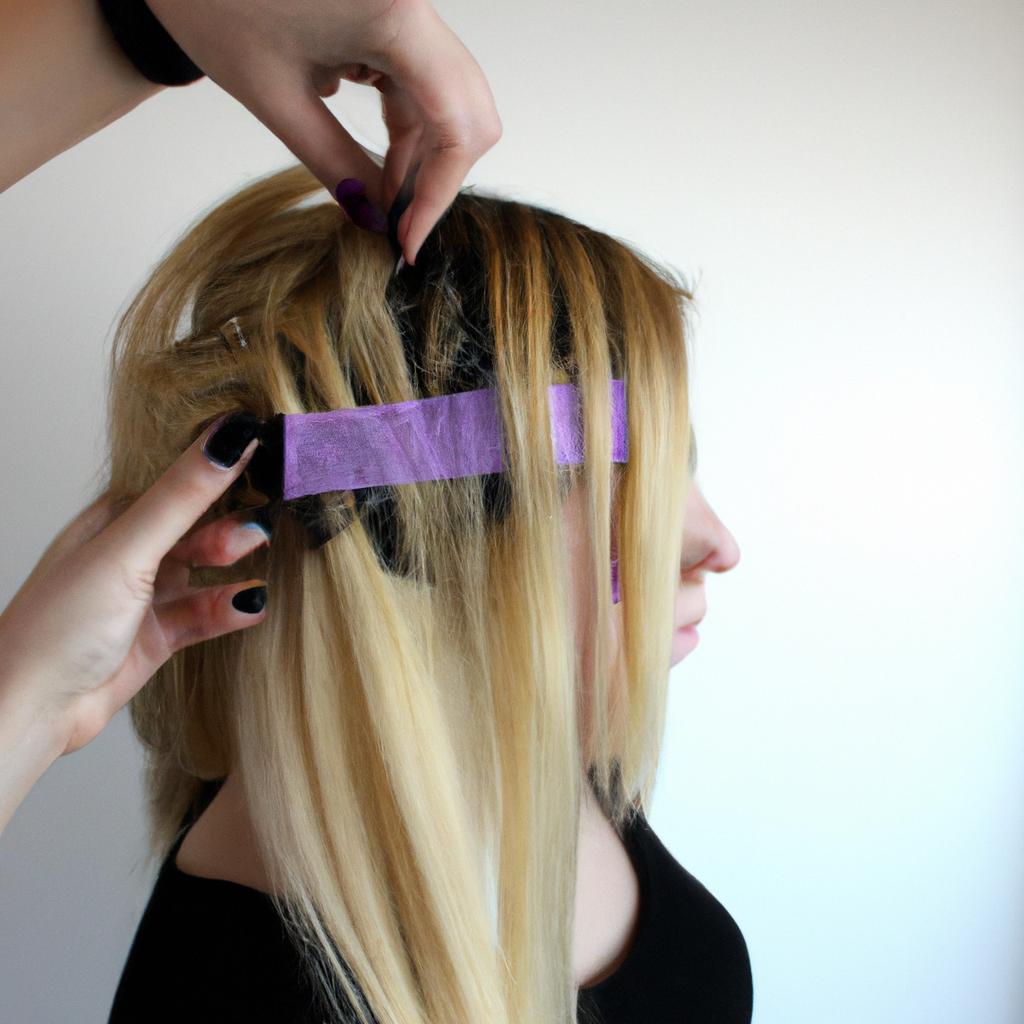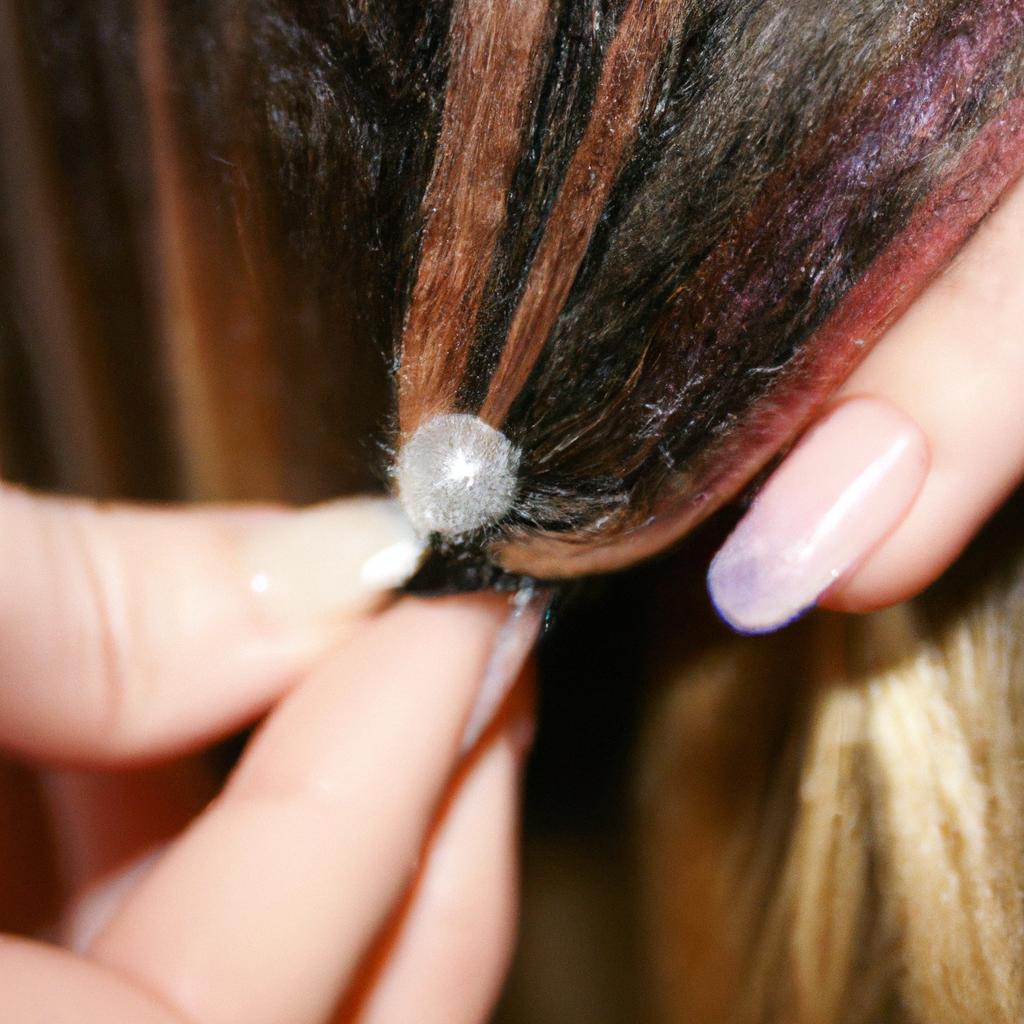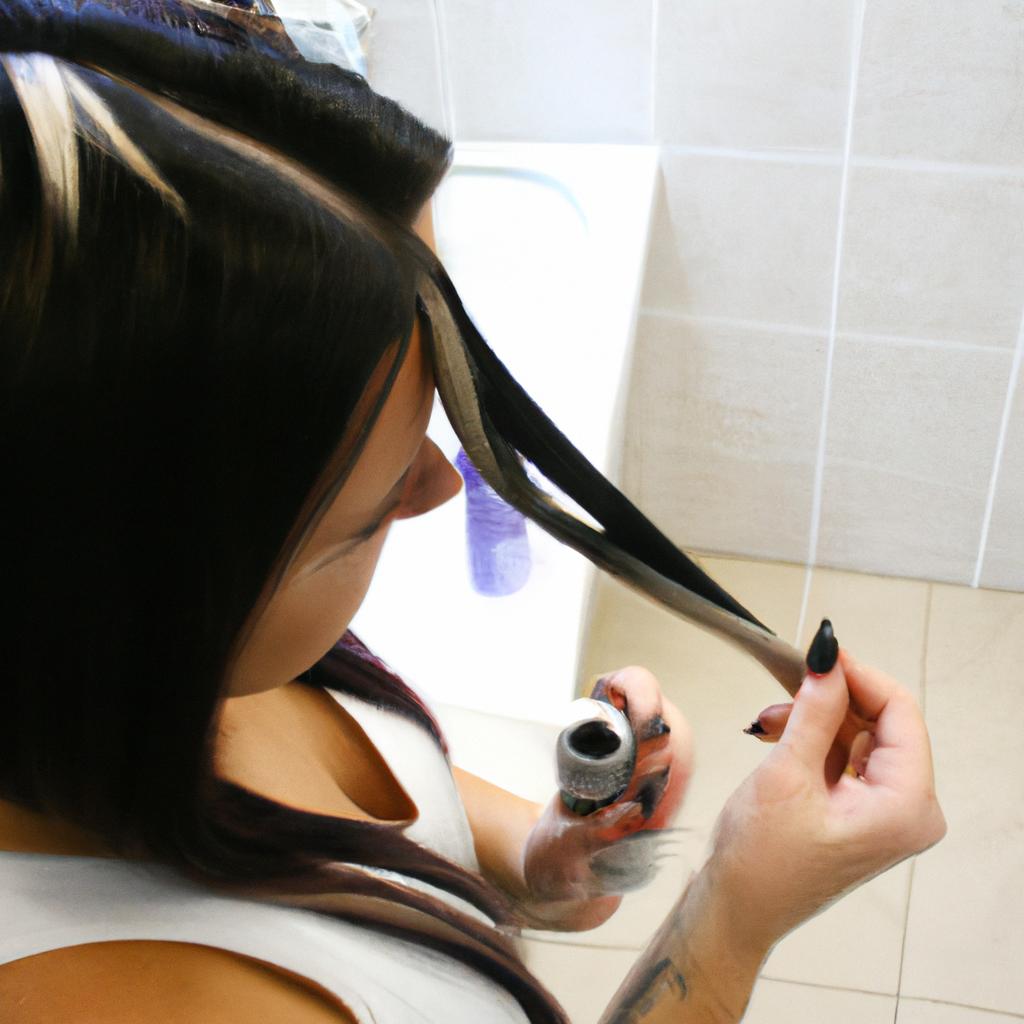Weft extensions have become increasingly popular in hairdressing salons as a method for achieving longer, fuller and more voluminous hair. This article aims to explore the various techniques used in weft extensions and highlight the benefits they offer to both clients and stylists. To illustrate these points, let us consider the case of Sarah, a young woman seeking a glamorous look for an upcoming event. By utilizing weft extensions, her stylist was able to transform her thin, shoulder-length hair into luxurious locks that cascaded down her back.
In recent years, there has been a surge in demand for weft extensions due to their versatility and ability to provide instant results. The integration methods employed by skilled professionals allow for seamless blending with natural hair, creating a flawless and natural-looking finish. Furthermore, unlike other extension options such as clip-ins or individual bonds, weft extensions are known for their durability and longevity. Clients can enjoy several weeks or even months of wear without experiencing any discomfort or damage to their own strands.
The benefits of weft extensions extend beyond aesthetic appeal; they also offer practical advantages from the perspective of hairdressers. With proper installation techniques, stylists can achieve remarkable transformations efficiently while maintaining the health and integrity of the client’s hair. Additionally , weft extensions can be easily customized to suit the client’s desired look. They can be cut, styled, and colored just like natural hair, providing endless possibilities for creativity.
One popular technique used in weft extensions is the sew-in method. This involves braiding the natural hair tightly against the scalp and sewing the wefts onto the braids using a needle and thread. The result is a secure and long-lasting installation that allows for easy maintenance and styling.
Another technique gaining popularity is the tape-in method. In this process, thin adhesive strips are applied to small sections of hair near the root, sandwiching the weft between two layers of hair. This method offers a seamless blend with minimal damage or stress on the natural hair.
Micro-link or bead extensions are also commonly used in weft installations. Small metal beads are clamped around individual strands of natural hair, securing the weft in place. This technique requires no heat or glue and offers flexibility in terms of movement and styling options.
Overall, weft extensions provide an effective solution for those seeking instant length and volume without compromising their own hair’s health. Whether it’s for a special occasion or everyday wear, these extensions offer versatility, durability, and stunning results that both clients and stylists will appreciate.
Types of Weft Extensions
Imagine a scenario where you walk into a hairdressing salon seeking to transform your hairstyle with extensions. As the stylist examines your hair, they suggest weft extensions as an ideal option for achieving the desired result. Weft extensions are strands of hair that have been sewn or bonded together at the top, creating a continuous strip. In this section, we will explore the various types of weft extensions available in hair salons.
Different Types:
Weft extensions come in several variations, each offering unique characteristics and benefits. The following bullet point list provides an overview:
- Machine-Tied Wefts: These wefts are created by machine sewing individual hair strands onto a stitching line. They offer durability and flexibility due to their strong construction.
- Hand-Tied Wefts: Crafted entirely by hand, these wefts provide a lighter weight and natural look. Their thin design allows for easier blending with natural hair.
- Skin Wefts: Also known as tape-in extensions, these wefts consist of ultra-thin adhesive strips that attach directly to the scalp. They provide a seamless finish and blend well with finer hair textures.
- Clip-In Wefts: Ideal for temporary transformations, clip-in wefts can be easily attached and removed without any professional assistance. They offer versatility and convenience when experimenting with different styles.
| Type | Construction | Weight | Application Difficulty |
|---|---|---|---|
| Machine-Tied | Machine-sewn | Moderate | Intermediate |
| Hand-Tied | Hand-sewn | Lightweight | Advanced |
| Skin (Tape-In) | Adhesive backing | Very lightweight | Beginner |
| Clip-In | Clips | Varies | Easy |
Understanding the various types of weft extensions available in hairdressing salons is crucial for both stylists and clients. Whether seeking durability, natural appearance, convenience, or versatility, there is a suitable option to meet individual needs. In the next section, we will delve into the application methods used when incorporating weft extensions into hairstyles.
With an understanding of the different types of weft extensions established, it is now essential to explore the techniques employed during their application. The subsequent section will shed light on these application methods without delving into step-by-step instructions.
Application Methods for Weft Extensions
Types of Weft Extensions
In the previous section, we explored the various types of weft extensions commonly used in hairdressing salons. Now, let us delve into the application methods for these extensions and understand how they can enhance one’s appearance.
Application Methods for Weft Extensions
To better illustrate the benefits of weft extensions, consider a hypothetical scenario involving Sarah, who desires to add volume and length to her fine hair. After consulting with a professional stylist at her local salon, she decides to opt for weft extensions as an ideal solution. The stylist explains three popular application methods that can be used:
-
Sew-in Method: This technique involves attaching the wefts to small braids created on the client’s natural hair. The braids act as a secure anchor for the extensions and provide a seamless blend between the client’s natural hair and the added strands.
-
Tape-in Method: In this method, thin adhesive tapes are used to attach the wefts directly onto sections of the client’s natural hair. This approach offers a quick and efficient way to apply extensions without causing damage or discomfort.
-
Micro-Ring Method: Also known as micro-bead or cold fusion method, this technique utilizes tiny metal rings that are clamped around individual strands of both the client’s natural hair and extension pieces. These rings are discreetly concealed within the hairstyle, providing a long-lasting and versatile option.
Applying any of these methods requires skillful execution by trained professionals to ensure optimal results for clients like Sarah. By selecting an appropriate application method based on factors such as lifestyle, desired look, and maintenance preferences, individuals can achieve their desired hairstyling goals effectively.
- Boosts self-confidence by enhancing one’s physical appearance.
- Allows individuals with thin or fine hair to achieve desired volume and thickness.
- Provides a sense of versatility by enabling various hairstyles and looks.
- Enhances self-expression and creativity through the opportunity to experiment with different colors, textures, and lengths.
Additionally, consider the following table that highlights some advantages of weft extensions:
| Advantages of Weft Extensions |
|---|
| Natural-looking results |
| Long-lasting durability |
| Easy maintenance |
| Non-damaging application |
As individuals seek ways to enhance their overall appearance, weft extensions offer an effective solution. In the subsequent section about “Advantages of Weft Extensions,” we will explore these benefits in further detail, shedding light on why they have gained such popularity among those looking for versatile hairstyling options.
Advantages of Weft Extensions
Exploring Techniques and Benefits in Hairdressing Salon Extensions
In the previous section, we discussed various application methods for weft extensions. Now, let us delve into the advantages that these extensions offer to both hairdressers and clients.
To illustrate the benefits of weft extensions, consider the following hypothetical scenario: Emily, a 25-year-old woman with fine shoulder-length hair, visits a salon seeking a dramatic transformation. She desires longer and fuller locks for an upcoming special event. The hairdresser suggests using weft extensions as they provide instant length and volume without causing damage or discomfort.
There are several reasons why weft extensions have gained popularity among both hairstylists and their clients:
- Versatility: Weft extensions can be applied using different techniques such as sewing, gluing, or clipping, making them suitable for various hair types and styles.
- Natural Appearance: When installed correctly by a skilled professional, weft extensions seamlessly blend with natural hair, creating a flawless look.
- Durability: Weft extensions are known for their longevity. With proper care and maintenance, they can last up to two months before needing adjustment or reinstallation.
- Enhanced Confidence: Weft extensions not only enhance physical appearance but also boost self-esteem. They allow individuals like Emily to achieve the desired aesthetic effortlessly.
| Benefit | Description |
|---|---|
| Versatility | Can be applied through multiple techniques |
| Natural Appearance | Blends seamlessly with natural hair |
| Durability | Lasts up to two months with proper care |
| Enhanced Confidence | Boosts self-esteem |
These factors combine to make weft extensions an appealing choice for those seeking temporary enhancements in their hairstyle. As demonstrated by our hypothetical example above, clients who opt for weft extensions can enjoy immediate gratification in achieving their desired look while maintaining the integrity of their natural hair.
Moving forward, let’s explore how important it is to provide proper maintenance and care for weft extensions, ensuring their longevity and continued satisfaction.
[Table created with markdown format]
Maintenance and Care for Weft Extensions
Exploring Techniques and Benefits in Hairdressing Salon Extensions
Advantages of Weft Extensions:
In the previous section, we discussed the numerous advantages that weft extensions offer. Now, let’s delve into the essential aspects of maintaining and caring for these extensions to ensure their longevity and natural appearance.
Maintenance and Care for Weft Extensions:
To illustrate the importance of proper maintenance, consider a hypothetical scenario where a client named Sarah visits a hairdressing salon to get weft extensions. After a few weeks, she notices that her extensions are becoming tangled and dull. This situation could have been avoided if Sarah had followed some key maintenance practices.
Firstly, regular brushing is crucial for keeping weft extensions looking smooth and tangle-free. Using a wide-toothed comb or a specialized extension brush, gently detangle the hair starting from the ends and working your way up towards the roots. Avoid pulling or yanking on the extensions as this can cause damage.
Secondly, it is vital to cleanse weft extensions adequately while avoiding excessive washing. Ideally, wash them every 7-10 days using sulfate-free shampoos specifically formulated for hair extensions. Focus on massaging the scalp rather than vigorously scrubbing the lengths to prevent tangling.
Lastly, protecting your weft extensions during sleep is essential to maintain their integrity. Before bed, loosely tie your hair in a low ponytail or braid to minimize friction against pillowcases. Additionally, investing in a silk or satin pillowcase can help reduce friction further and prevent tangles.
Emphasizing the significance of proper maintenance techniques through bullet points:
- Regular brushing with appropriate tools
- Adequate cleansing without excessive washing
- Protecting extensions during sleep by tying them up or using silk/satin pillowcases
- Seeking professional advice when encountering any issues
Table demonstrating different types of brushes suitable for weft extension care:
| Brush Type | Description | Benefit |
|---|---|---|
| Wide-toothed comb | Gentle detangling | Prevents damage and breakage |
| Extension brush | Designed for extensions | Ensures smooth brushing without tangles |
In conclusion, maintaining and caring for weft extensions is essential to prolong their lifespan and preserve their natural appearance. By following these simple practices, like regular brushing, proper cleansing, and protecting them during sleep, clients can enjoy beautiful extensions that remain vibrant and tangle-free.
Transition into the subsequent section about “Choosing the Right Weft Extensions”:
Now that we have explored maintenance techniques, let’s shift our focus to another important aspect of achieving optimal results with weft extensions – choosing the right type of extensions for your individual needs.
Choosing the Right Weft Extensions
However, it is important to understand that proper maintenance and care are essential to ensure the longevity of these extensions. Let us delve into some key aspects that should be considered when caring for weft extensions.
Firstly, regular washing and conditioning are crucial for maintaining the quality of weft extensions. It is recommended to use sulfate-free shampoos and conditioners specifically designed for hair extensions. These products help retain moisture without stripping away the natural oils from both the scalp and the extension hair.
Secondly, brushing or combing weft extensions requires gentle handling to prevent any damage. Start by detangling the ends first using a wide-toothed comb or a specialized extension brush. Work your way up gradually towards the roots, being careful not to tug or pull on the extensions excessively. This approach helps minimize breakage and keeps the strands intact.
Thirdly, protecting weft extensions during heat styling is imperative. Prior to using hot tools such as curling irons or straighteners, apply a heat protectant spray evenly throughout the length of the extensions. Set them at lower temperature settings to avoid unnecessary heat exposure, which can lead to dryness and frizz.
To illustrate further, consider this hypothetical scenario: Emma recently got weft extensions installed at her favorite salon. She diligently followed all maintenance guidelines provided by her stylist but noticed that after a few weeks, her extensions started tangling easily despite her efforts. Upon closer inspection, she realized that she had been neglecting one crucial aspect – sleeping with wet or damp hair! Moisture trapped between the extension bonds caused them to stick together overnight, leading to increased tangles and difficulty in managing her hair.
To emphasize the importance of proper care for weft extensions, let’s take a moment to explore some potential consequences of neglecting maintenance:
- Increased risk of matting and tangling, resulting in a less natural appearance.
- Weakened hair strands leading to breakage and shedding of the extensions.
- Build-up of product residue that can make the extensions appear dull and lifeless.
- Scalp irritation or discomfort caused by improper cleansing routines.
In summary, maintaining weft extensions requires consistent care and attention. By following the recommended washing techniques, using gentle brushing methods, protecting against heat damage, and avoiding common pitfalls like sleeping with wet hair, clients can enjoy their weft extensions for an extended period while keeping them in optimal condition.
Now that we have discussed the essential aspects of maintenance and care for weft extensions, let us move on to exploring how to choose the right type of weft extension based on individual needs and preferences in the next section. But before that, it is worth examining current trends and innovations within the field of weft extensions.
Trends and Innovations in Weft Extensions
Exploring Techniques and Benefits in Weft Extensions
Now, let us delve into the various techniques used in hairdressing salon extensions and explore the benefits they offer to both hairstylists and clients.
One technique that has gained popularity is the sew-in method. This involves attaching wefts of hair to small braids created on the client’s natural hair. The tightly woven braids provide a strong foundation for securing the wefts, ensuring durability and longevity. Additionally, this technique allows for maximum versatility as the wefts can be styled in different ways without any fear of slippage or damage.
Another popular technique is tape-in extensions. With this method, adhesive tapes are used to secure thin strips of wefts onto sections of the client’s natural hair. The lightweight nature of these extensions ensures a comfortable experience for the wearer. They also blend seamlessly with natural hair, providing a more natural look compared to other methods. Moreover, tape-in extensions are easy to maintain and require minimal effort when it comes to styling.
Fusion bonding is another technique that deserves attention. In fusion bonding, individual strands of extension hair are attached to the client’s natural hair using specialized adhesives or heat connectors. This method offers excellent flexibility in terms of customization since each strand can be strategically placed according to desired volume or length. While fusion bonding requires more time during application than other methods, its long-lasting results make it worth considering.
Now let’s take a moment to consider some emotional aspects related to weft extensions:
- Increased self-confidence: Weft extensions give individuals an opportunity to transform their appearance by adding length, volume, or even experimenting with different colors.
- Enhanced beauty routines: With longer and fuller locks achieved through weft extensions, individuals may feel inspired to try new hairstyles and experiment with creative looks.
- Empowered self-expression: Weft extensions provide a means for individuals to showcase their personal style and express themselves through their hair.
- Improved overall well-being: Feeling satisfied with one’s appearance can positively impact self-esteem, leading to increased happiness and confidence in daily life.
To provide a visual representation of the different techniques discussed above, consider the following table:
| Technique | Description |
|---|---|
| Sew-in | Wefts attached to braids created on natural hair |
| Tape-in | Thin strips of wefts secured using adhesive tapes |
| Fusion bonding | Individual strands bonded to natural hair using adhesives or heat connectors |
In conclusion, exploring various techniques in weft extensions opens up a world of possibilities for hairstylists and clients alike. Whether it’s sew-in, tape-in, or fusion bonding, each method offers unique benefits that cater to individual preferences and needs. The emotional aspects related to weft extensions further emphasize the transformative power these extensions can have on an individual’s self-confidence and overall well-being.




